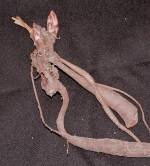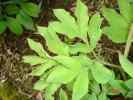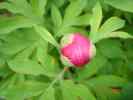accepted name
(2005)
Baker (1884):
20. P. arietina Anders., Monogr., No. 10; DC., Prod., i., 66. P. tartarica, Miller, Gard. Dict., edit. vi. No. 5 (Icones, t. 199). P. cretica (Clusius), Sabine ; Lindl., in Bot. Reg., t. 819. P. lobata, Reich., Ic. Germ., t. 123, fig. 4741 a, non Desf.—Stem 3—3 feet long, hairy upwards, with never more than a single flower. Leaves 5—6 on a stem, green and glabrous above, pale green, or rather glaucous and pubescent beneath, the oblong or oblong-lanceolate segments copiously confluent, and not more than 1—1 ½ inch broad, about thirty in the fully developed lower leaves. Corolla dark red in the type, 4 inches in diameter. Follicles 3—4, densely tomentose, ovoid, spreading almost horizontally from the base, when mature 1inch long, ½ inch diameter; stigma small, dark red, recurved. This is well-known in gardens, but il is not distinct from peregrina in a broad sense, and no doubt is included under that name by Boissier and other authors of Floras from the various regions of Southern Europe. Miller's figure just cited represents excellently the ordinary garden form of the plant. P. cretica is distinguished from the type by "its dwarfer habit, flesh-coloured flowers changing to nearly white, and shining coriaceous flat blistered leaves, which are very glaucous beneath."
Lynch (1890):
20. P. arietina, Anders.—
The largest species of this section. It is well marked by decurrent leaflets, with strongly arched and even recurved carpels when mature. South of Europe.
var. Andersoni.—
Leaves blue glaucous green. Corolla deep rose, petals slightly crisped. Perhaps native of the Levant.
var. cretica (P. arietina oxoniensis, Anders.; P. cretica, Clusius).
Leaves pale green. Corolla pale rose, or nearly white, petals lacerated. This is one of the earhest of Paeonies, and may be known as it comes out of the ground in spring by the pale glaucous green colour of the leaves. Mountains of Crete.
Stern (1946):
Passalaqua & Bernardo (Passalaqua, Nicodemo G. & Bernardo, Liliana: The genus Paeonia L. in Italy: taxonomic survey and revision. Webbia 59(2): 215-268. 2004. ) stated, that Sterns description is fitting for P. off. ssp. banatica!!
26. P.arietina Anderson in Trans. Linn. Soc. London, 12, 275 (1818) ; DC. Prodr. 1, 66 (1824) ; Baker in Card. Chron,, New Ser. 22, 10 (1884) ; Lynch in Joum. Roy. Hort. Soc. 12, 440 (1890) ; Bailey, Stand. Cycl. Hort. 5, 2435 (1916) ; F. C. Stem in Jown. Roy. Hort. Soc. 68, 127 (1943).P.arietina var. Andersoni Lynch, I.e. (1890). P. arietina var. cretica (Sabine) Lynch, I.e. (1890).P.corallina Retz. var. pubescens Hayek, Prodr. Fl. Penlns. Balcan. 1 (in Fedde, ReP.SP.JVoii. Beih. 30, i), 297 (1924). P.cretica Sabine in Bot. Reg. t. 819 (1824) ; Saunders in Nat. Hort. Mag. t. P.217 (1934). P.peregrina Mill. sec. Boissier, FL Orient. 1, 97 (1867), non Mill. P.peregrina var. latifolia Boissier, I.e. (1867). ?P.pubescens Schlosser & Vukotinovic, FL Croatica, 189 (1869). P.rosea Host, Fl. Austr. 2, 64 (1831), pro parte, nonJaume St. Hil. (1809). P. Russi Biv. sec. Halacsy, ConsP.FL Graec. 1, 35 (1901), non Biv.
Description. Stem sparsely villous, 45-75 cm. high. Lower leaves bitemate, with one or more of the leaflets deeply divided, and the leaflets sometimes confluent at the base ; leaflets oblong or narrow elliptic to broad elliptic, acute to subacute, cuneate at the base, green and glabrous above, glaucous and villous below ; petiole villous, densely so at the base. Flower 8-12 cm. across. Petals obovate, red. Stamens 2 cm. long, filaments red, anthers yellow. Carpels 2-3, densely pubescent. Follicles 2-3 cm. long.
Distribution. South-eastern Europe and Asia Minor. italy : Lippiza wood, near Trieste, Bentham 382 (K.) ; prov. Modena, near Cartagneti, from Varana to Sassomereo, A. Mor (K) ; Aemilia, prov. Bologna, Rio Maggiore andJano, near Sasso, Fiori (K). greece : Mt. Helikon, Atchley sow (K) ; Mt. Parnassus, near Carcaria, Orphanides 445 (K), Herb. J. S. Mill (K). bosnia : Praca, Curcic (K); Mt. Rudinica, near Bauja Hyena, 960 metres, K. Maly (K). anatolia : Mt. Ida, near Kareikos, Sintenis 459 (K) ; Kazikli, Whittall 204 (K) ; Kurd Dagh, 1220-1520 metres, Haradjian 1103 (K); Amasya, Manisadjan 1166 (K). armenia : Above Taltaban, Szanschak, Gumuschkane, Sintenis 5591 (K) ; Fstavros, Gumuschkane, Sintenis 1780 (K); Erzeroum, Zorab (K); sine loc. Cavert and Zohrab (K). kurdistan : sine loc. Layard (K). samos : Mt. Ambelos, Rechinger ySOg (K).
Paeonia arietina has a wide distribution, Greece and Asia Minor being the main centres. The species is variable both in the size of the leaflets and the shades of colour of the flowers and also in the hairiness of the stem, petioles and the back of the leaves. The main characters are the leaflets bifurcating into 12 or 15 somewhat narrow segments which are acute or subacute at the apex, with the back of the leaves, petiole and stem villous, and the carpels densely pubescent with short hairs ; the forms found in Armenia and Syria are more densely villous than the majority of specimens. The flowers are usually a reddish-pink but the specimens from Greece are a dark red which, when dried,become a deep chocolate red. [end page 81]
P.arietina differs from P.mascula in the greater number of segments, the hairiness of the undersides of the leaves, petiole and stem, and in the size and shape of the segments which on the average in P.mascula are 5.5-12 cm. long by 2-6 cm. wide and in P.arietina 7.5-13.5 cm. long by 2.5-6.5 cm. wide. Both P.arietina and P.mascula are tetraploids.
P.banatica from Transylvania has been sometimes considered to be a form of P.arietina l but it appears to be somewhat half-way between P.mascula and P.arietina, with some of the characters of each ; the differences between these paeonies are referred to under P.banatica. Huth (1891) considered P.arietina to be conspecific with P.peregrina; it differs from P.peregrina in that the latter is completely glabrous except the carpels. The segments of the leaves in P.peregrina are coarsely toothed and almost acuminate. Also the hairs of the carpels in P.arietina are dense but short, while in P.peregrina they are dense and long. The flowers of .P, arietina open widely while those of P.peregrina are cup-shaped with the petals concave, a special feature of this paeony.
P.arietina is a common plant in gardens and of the easiest cultivation. There is a white form of P.arietina which has grown for many years in the garden of the late Sir Michael Foster, near Shelford, Cambridgeshire. [end page 82]
Cullen & Heywood (1964):
P. mascula (L.) Mill., Gard. Dict. ed. 8, No. 1 (1768).
(a) subsp. mascula
Syn. P. corallina retz., Obs. Bot. 3: 34 (1783).
Distribution: Widespread in S. Europe and the southern parts of C. Europe: France, Italy, Siciliy, Germany, Jugoslavia, Romania, ? Hungary, Bulgaria, Greece, Russia (West).
(b) subsp. russii (Biv.) Cullen & Heywood, comb. et stat. nov.
Syn. P. russii Biv., Stirp. Rar. Sic. Descr. Man. 4: 12 (1816).
Distribution: Corsica, Sardinia, Sicily, Italy, (Calabria).
Stern (1946) recognizes two variants of P. russii with glabrous carpels, var. reverchonii Le Grand and var. leiocarpa (Cosson) Stern. They may be accomodated within subsp. russii as minor variants. The identity of the gathering of reverchon from Corsica cited by stern has caused some difficulties. As frequently occurs with reverchon's collections, the sheets under the same number differ from one herbarium to another.
Those at Edinburgh (E) and Kew (K) possess mascula-like fruits which are truncate at the apex, with a short style, while those at Liverpool (LIVU) and Manchester (MANCH) have coriacea-like fruits with a long tapering apex and a long style. It seems most probable that Reverchon's material was not all collected from the same place but was given the same number by him (a not infrequent failing of his) and there has been a confusion in labelling.
(c) subsp. arietina (Anders.) Cullen & Heywood, comb. et stat. nov.
Syn. P. arietina Anders., Trans. Linn. Soc. Lond. 12: 275 (1818). Distribution: Crete, Greece, Italy, Jugoslavia, W. Russia and Turkey.
As in the case of P. officinalis the variation in P. mascula seems best treated as a scries of subspecies. Intermediates between them occur.
Davis & Cullen in Flora of Turkey (1965)
1. P. mascula (L.) Miller, Gard. Dict. No. 1(1768).
Syn: P. officinalis var. mascula L., Sp. Pl. 530 (1753).
Leaves simply biternate, or with some leaflets further divided, thus with 9-16 narrowly to broadly elliptic segments, glabrous to pilose beneath. Flowers 8-14 cm across, petals red. Follicles 3-5, 2-4 cm, white-tomentose, with a truncate apex and sessile stigma. - A complex species, of which 2 subspecies occur in Turkey:
1. Leaves pilose beneath with 12-16 segments
subsp. arietina
1.Leaves glabrous or sparsely pilose beneath with 9-10(-12) segments
subsp. mascula
subsp. mascula.
Syn: P. corallina Retz., Obs. Bot. 3: 34 (1783); P. kevachensis Azn. in Mag. Bot. Lap. 16: 7 (1917); P. corallina var. caucasica Schipcz. in Not. Syst. Leningrad 2: 45 (1921)! P. caucasica (Schipcz.) Schipcz. in Fl. URSS 7: 28 (1937); P. corallina var. orientalis Thiéb., Fl. Lib.-Syr. 1: 37 (1936); P. arietina var. orientalis (Thieb.) Stern in J. Roy. Hort. Soc. 68:127 (1943); P. kurdistanica Zoháry in Pal. J. Bot., Jer. ser. 2:155 (1944).
Ic.: Stern, Study of Paeonia 68-69 (1946). Fl. 4-6. Oak and beech scrub, rocky slopes, 1000-2200 m.
[204]
Described from Switzerland.
S. Anatolia, Kurdistan, Islands.
C3 Antalya: Teke Da., 1100-1200 m, D. 15199!
C6 Hatay: Antakya to Yayladag, 1000 m, D. 27159!
Seyhan: d. Bahçe, Dumanli Da., 1300 m, D. 26879!
C9 Bitlis: d. Kotum, Karz Da., 2200 m, D. 24603!
Is.: Samos, D. 1639!
Scattered through Europe, Caucasia, Cyprus, N. Iraq, N. Iran.
subsp. arietina (Anders.) Cullen & Heywood in Feddes Rep. 69:35 (1964).
Syn: P. arietina Anders. in Trans. Linn. Soc. Lond. 12: 275 (1818); P. peregrina sensu Boiss., Fl. Or. 1: 97 (1867) non Miller; P. russii sensu Hal., Consp. Fl. Graec. 1: 35 (1901) non Biv.
Ic.: Stern, Study of Paeonia 81-82 (1946). Fl. 6-7. Scrub, thickets, rocky slopes, 1000-2000 m.
Described from plants cultivated in Britain.
N. & Inner Anatolia, Mysia, Islands.
A5 Amasya: Mersifon, Maniss.!
A7 Gümüþane: Gümüþane:, Bourgeau 5!
A8 Gümüþane: S foot of Soganli Da., 1700 m, D. 31990!
Trabzon: between Bayburt and Rize, 1800 m, Furse & Synge 805!
B1 Balikesir: Ida (Kaz Da.), Sint. 1883:459!
B5 Yozgat: Yozgat, Curtis 116!
B7 Tunceli: Pülümür to Selepur, 1900 m, D. 29299!
B8 Elazig: 32 km W of Bingol, D. 24809!
B9 Bitlis: Karz Da., 2000 m, D. 24556!
Is.: Samos, Rech. 3889.
Italy, Balkan Peninsula. The two subspecies show much less morphological overlap in Turkey than they do in the Balkans, where many specimens cannot be assigned with certainty to either. Subsp. arietina is found mainly in the less arid parts of the Ir.-Tur. region, and is the commonest peony in Turkey.
Cullen & Heywood in Tutin: Flora Europaea 2nd Ed. (1993):
8. P. mascula (L.) Miller, Gard. Dict. ed. 8, no. 1 (1768) (P. corallina Retz., P. caucasica (Schipcz.) Schipcz.; incl. P. banatica auct., non Rochel). Stems 20-80 cm. Leaves simply biternate, or with a few leaflets divided; segments 9—16 (—21), narrowly to broadly elliptical to ovate or orbicular, glabrous or pubescent beneath. Flowers 8—14 cm in diameter, red or rarely white. Follicles (2)3-5(6), 2—4 cm, usually villous, rounded at apex, with a sessile stigma. S. Europe, extending northwards to N.C. France and Austria. Al Bu Co Ga Gr Hs It Ju Rm Rs(K) Sa Si [Au Br].




















